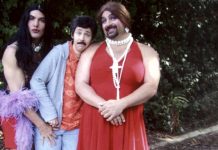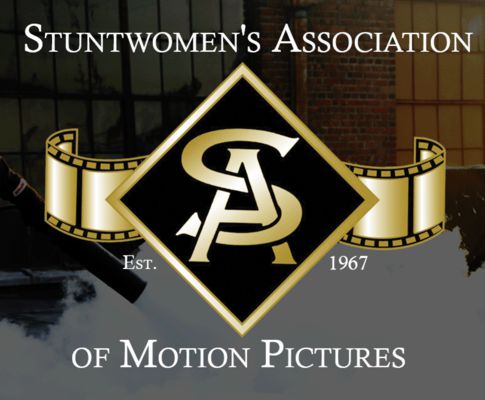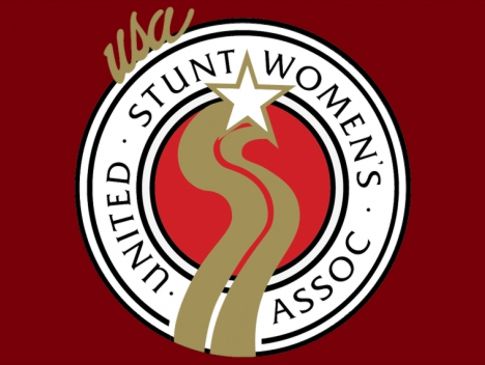Helen Gibson was an American film actress, vaudeville performer, radio performer, film producer, trick rider and rodeo performer; and is considered to be the first American professional stuntwoman. She was born on August 27, 1892 and she passed away on October 10, 1977.
Helen Gibson was born Rose August Wenger in Cleveland, Ohio on August 27, 1892. She was one of five girls born to Swiss-German parents. Her father wanted a son and encouraged her to be a tomboy. In Cleveland in the summer of 1909, Helen saw her first Wild West show and she saw a Miller Brothers 101 Ranch ad for girl riders in Billboard magazine and she answered the ad. They taught her to ride, and she performed in her first 101 Ranch Real Wild West Show in St. Louis in April 1910.
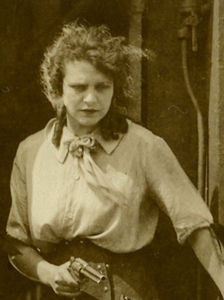
Helen said, “( I ) was already practicing picking up a hand-kerchief from the ground at full gallop. When veteran riders told me I could get kicked in the head, I paid no heed. Such things might happen to others but could never happen to me, I believed. We barnstormed all over the US and the season ended all too soon. I was sorry when I had to go home, and could hardly wait to open in Boston in the spring of 1911.”
The Miller-Arlington Show suddenly closed in 1911 and this left many performers stranded in Venice, California. Lucky for the cast, Thomas H. Ince was producing for the New York Motion Picture Company and he hired the entire cast to work for the winter paying $2,500 a week. This gave each performer $8 a week and they boarded in Venice, near where the horses were stabled. They had to ride five miles each day to work in Topanga Canyon, where the films were being shot. In 1912 Helen Gibson got her first billed role as Ruth Roland’s sister in Ranch Girls on a Rampage. She made $15 a week.
Helen Gibson continued to perform in rodeos between pictures, just as many of the cowboy extras, did. At the Second Los Angeles Rodeo in 1913 she was featured in the Standing Woman Race. She so impressed one of the investors that he financed a tour of rodeos for her. He paid all her expenses and they split the winnings. At his ranch outside of Pendleton, Oregon, Helen worked his horses every day and she learned new forms of trick riding. Helen met Edmund Richard “Hoot” Gibson (1892-1962) in Pendleton in June 1913 and they began working together. They performed in a rodeo in Salt Lake City and together they won everything, including the relay race, the standing woman race, trick riding, and Hoot won the pony express race. The promoter of the rodeo skipped town and neither Helen or Hoot received a penny of the prize money they’d won.
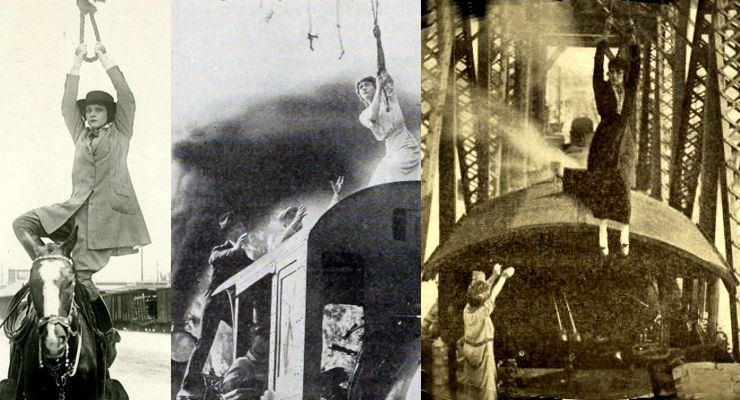
That summer Helen and Hoot performed in rodeos in Winnipeg, Canada and Boise, Idaho. They arrived back in Pendleton a few days before the Pendleton Round-Up began. Rooms were almost impossible to obtain, so they decided to “tie the knot” because married couples were given preference. They lucked out and the landlady gave them her own room. The couple won enough money to return to Los Angeles. Hoot was able to get work at the Selig Polyscope Company in the Edendale district of Los Angeles (Echo Park), as a cowboy extra and he doubled for Tom Mix. Helen also worked for Selig and for the Kalem Studios in Glendale.
While on the Kalem payroll, Helen began doubling for Helen Holmes in The Hazards of Helen (1914) adventure film series. In April 1915 Helen performed what is thought to be her most dangerous stunt: a leap from the roof of a station onto the top of a moving train in the A Girl’s Grit episode. They accurately measured the distance between station roof and train top and she practiced the jump while the train was standing still. On camera, the train had to be moving for about a quarter of a mile and its accelerating velocity was timed to the second. Helen leapt from the station roof without hesitation and she landed correctly, but the train’s motion made her roll toward the end of the car. Always the actress, she caught hold of an air vent and hung on, dangling over the edge to increase the effect on screen. She suffered only a few bruises.
The real difficulty of the stunt lay not in the leap itself; since she had practiced this with the train stationary and it clearly presented no difficulties, but in the timing. What such stunts require is an inbuilt awareness of the speed of the moving object. During the course of a leap where a moving object is concerned, the spatial relationship between take-off point and landing point changes. It is quite possible to imagine a leap from a static take-off point on to the roof of a moving train in which the stuntman aims to land halfway along a carriage roof yet in fact-because of the speed of the train-lands in the gap between two carriages. It seems that in such a leap the safest place to aim at is the gap itself At least in that way one can guarantee to miss it. Helen Gibson had this sensitivity to spatial relationships between objects in motion, but it is certainly not a gift shared by all stuntmen. Arthur Wise from Stunting In the Cinema, 1973.
The 119 The Hazards of Helen episodes are stand-alone stories, instead of chapters and they are considered the longest serial in history. The highly successful series had begun with Helen Holmes in the lead role for the first 49 episodes. When Helen Holmes became ill, Helen Gibson was given the chance to take her role for two pictures. Helen Gibson starred in A Test of Courage and A Mile a Minute and she was paid $35 a week. The Kalem New York office were impressed by Helen Gibson’s work, and they instructed Glendale to keep her on when Helen Holmes and her husband, Hazards of Helen director, J. P. McGowan left to form their own company.
She was rechristened ‘Helen’ by the studio, and she proved to be an adept actress She made several more pictures and then she wrote a story for a 1-reeler that required her to perform a risky stunt. Her story required her to catch a runaway train by detaching a team of horses, riding them “standing woman”, and then she had to catch a rope dangling from a bridge. She would use the rope to swing from the horses and onto the train as it came under the bridge. Kalem rewarded her by raising her salary to $50 a week.
Helen Gibson performed in The Hazards of Helen for 69 episodes but the series ended in February 1917. Kalem began producing another serial with Helen as the star. It was called the Daughter of Daring. One of her best stunts appeared in this serial. She would travel at full speed on a motorcycle chasing after a runaway freight train, She rode through a wooden gate, shattering it completely, then up a station platform, and through the open doors of a boxcar on a siding. Her motorcycle would travel through the air until it landed on a flatcar in a passing train. The trick was to undercrank the camera to speed up the action, executing all with flawless timing.
Kalem produced single-reel films, and this type of films were in decline. Rather than risking financial failure producing feature films, Kalem ceased production in 1917 and was bought by Vitagraph. Universal then offered Helen a three-year contract until 1919 at $125 a week for 2-reel, and 5-reel pictures. She made two 1919 John Ford films, Rustlers and Gun Law. Her Universal contract ended with the winter of 1919 and she signed with Capital Film Company for $300 a week. Capital was already losing money and went out of business in May 1920.
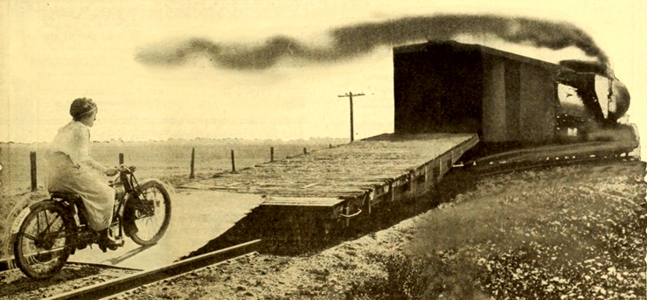
Helen’s husband, Hoot Gibson, had joined the Army tank corps. He returned during the Christmas of 1918, Universal gave him a contract to appear in 2-reel westerns. Helen had become a very successful movie star while he was away, but Hoot’s ego couldn’t handle her fame and the couple separated in 1920. The Census records from 1920 indicate that they were living separately. Hoot Gibson had listed himself as married, and Helen listed herself as a widow. In 1922, Hoot married a woman named Helen Johnson, who is often confused with Helen Gibson. In 1923, Hoot and Helen Johnson Gibson had their only child, Lois Charlotte Gibson; and divorced in 1930.
In 1920 Helen Gibson created Helen Gibson Productions to produce her own films inwhich she would star. Her first film was to be No Man’s Woman, a Western melodrama about a kind-hearted dance-hall hostess rescuing a rancher’s child. The film was never finished, as she ran out of money and was personally bankrupted. A year later the film was released by another studio with a new title, Nine Points of the Law. In March 1921, the Spencer Production company hired Helen Gibson to star in the Wolverine. They were so pleased with her performance that they put her on the payroll, paying her $450 a week. Before shooting began on her second picture, Helen’s appendix ruptured and she ended up in the hospital battling peritonitis. The studio had her replaced in the film.
Helen Gibson’s popularity as a lead had waned while she was forced to take time to recover from surgery. She was hired by an independent company in 1921 for a 5-reeler but the company folded without paying the cast or crew. Riding in the picture put Gibson back in the hospital, forcing her to sell her furniture, jewelry and even her car. She made personal appearances in connection with bookings of No Man’s Woman and The Wolverine in theaters and at rodeos. She also visited her old friends at the 101 Ranch in Ponca City, Oklahoma.
In the spring of 1924 Helen got a job trick riding with Ringling Bros. and Barnum & Bailey Circus’ Wild West show. The show included other cowboy performers such as Ken Maynard. Helen performed in their ‘after show’ for two-and-a-half years. In September 1926 Gibson joined a Hopi Indian act and worked the Keith Vaudeville Circuit out of Boston.
Helen Gibson returned to Hollywood in 1927 and began doubling for stars such as Louise Fazenda, Irene Rich, Edna May Oliver, Marie Dressler, Marjorie Main, May Robson, Esther Dale and Ethel Barrymore. She worked constantly as a stunt double and to uncredited or bit parts. As she had done in her heyday, Helen became a featured guest at benefit rodeos and events such as the Annual Santa Barbara Horse Show.
In 1935, Helen married Clifton Johnson, a studio electrician who had been a chief gunner in the Navy. In 1940 he asked for active duty, and while he was serving in World War II, she carried on working as an extra and became treasurer of the stunt girl’s fraternal organization.
In Universal’s Hollywood Story (1951), she was cast as a retired silent film actress alongside Francis X. Bushman, William Farnum, Betty Blythe and earned $55 for one scene. Tony Curtis, then unknown, was assigned to escort Gibson and Blythe to the premier at the Academy Award Theater at the Academy’s then-headquarters on Melrose Avenue in Hollywood. Here The Hollywood Chamber of Commerce gave each silent star a plaque “for your outstanding contribution to the art and science of motion pictures, for the pleasure you have brought to millions over the world, and for your help in making Hollywood the film capital of the world.”
Helen Gibson continued to take character parts and extra work until 1954, when the couple moved to Lake Tahoe for health reasons. After trying unsuccessfully to sell real estate they returned and bought a home in Panorama City, in the San Fernando Valley. Gibson suffered a slight stroke in 1957, but it did not prevent her working as an extra in film and television.
Helen Gibson’s last role was in John Ford’s The Man Who Shot Liberty Valance (1961). She was paid $35 and she was 69 years old. Helen retired in January, 1962 on a Motion Picture Industry Pension of $200 a month plus social security. The couple moved to Roseburg, Oregon where she spent her later years fishing and giving the occasional interview. Helen Gibson died of heart failure following a stroke in 1977. She was 85 years old.
Source: Wikipedia





